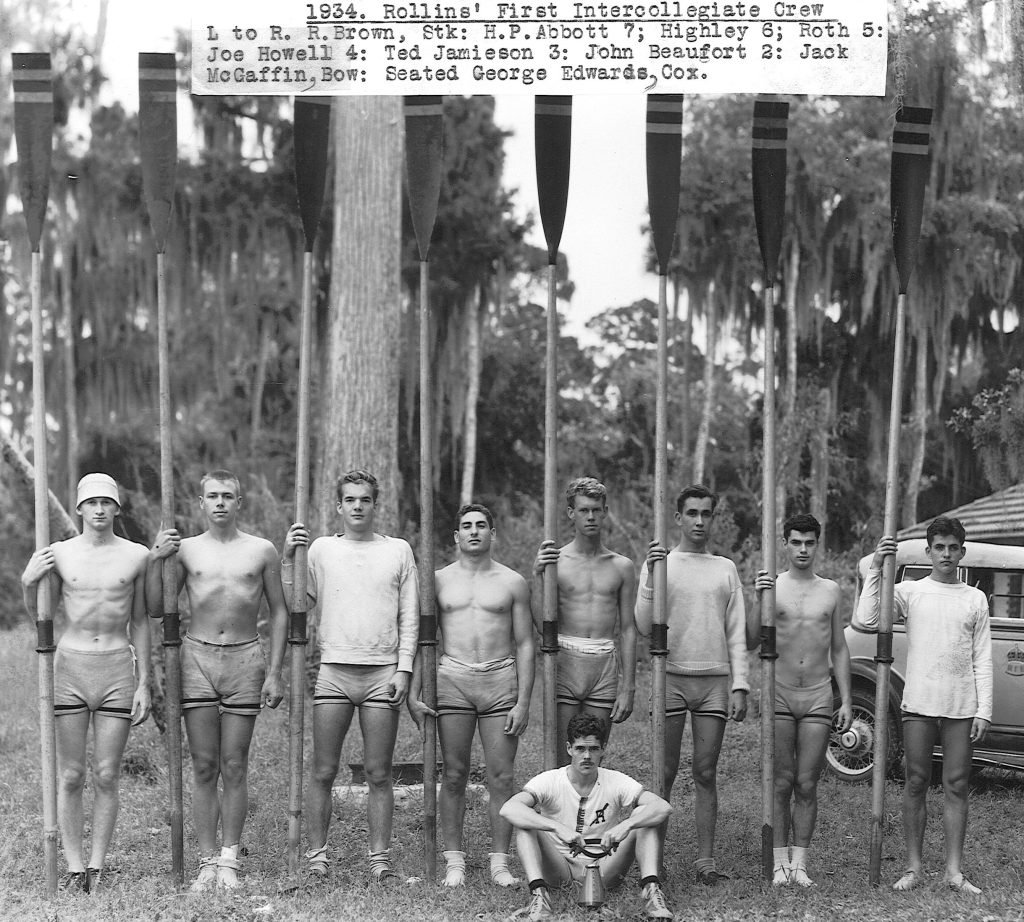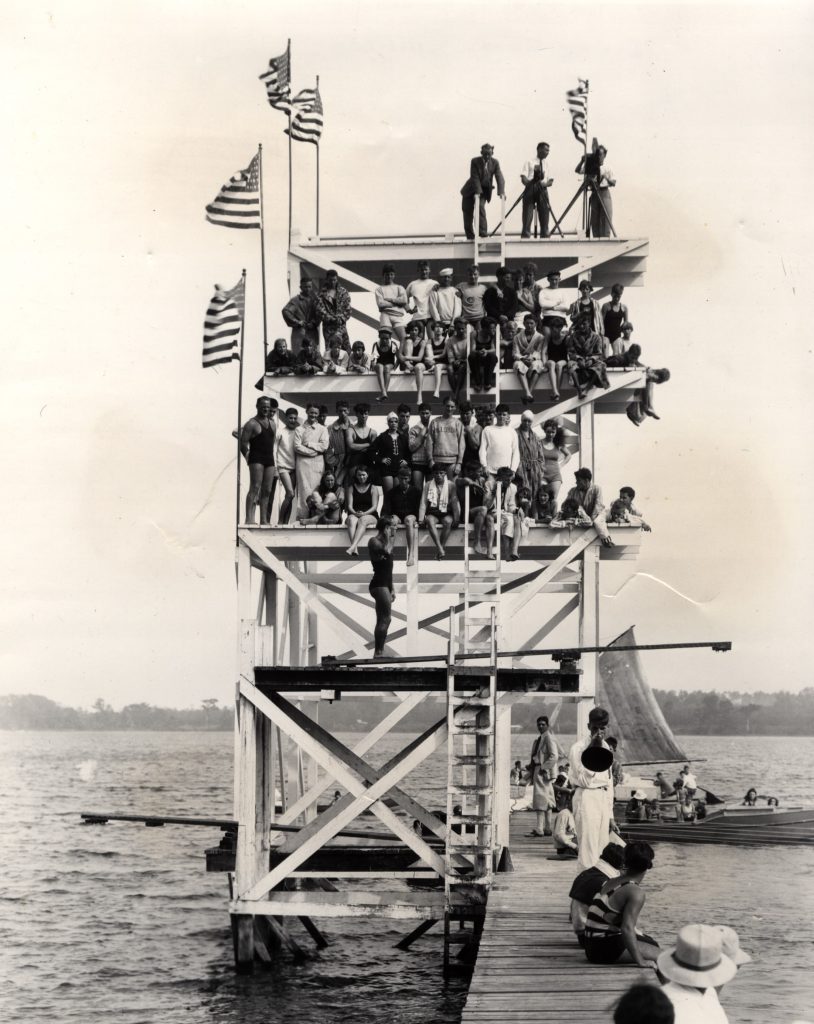Written by Peyton Connor ’24

Rollins students participating in a “boating party” on Lake Virginia in 1889.
Rollins College, established in 1885, has always boasted of its location on and intimate relationship with beautiful Lake Virginia. Since the founding, photos and mentions of the lake have been and continue to be on advertisements, webpages, and informational pamphlets produced by the College. In the late 1800s, a huge selling point for students and faculty to come to Rollins was the benefit of living and learning in a warm climate near a scenic body of water. This was especially appealing to prospective students who were struggling with health issues such as tuberculosis.[1] The Rollins marketing materials of the time failed to mention, however, the link between living on a lake and malaria. Regardless, students from all over (but specifically the Northeast) flocked to Winter Park’s lakeside setting.
“It is while the northern lakes are covered with ice that Rollins turns out in bathing suits to paddle gaily about the warm waters of Lake Virginia. While would-be skaters are vainly trying to find a place to skate on these same frozen lakes, under three or four feet of snow, students here paddle in canoes to the orange groves which line the shores of the beautiful Winter Park lakes.”[2]
Going to college on the lake had other benefits besides helping with illness, namely, the environment allowed for an abundance of water sports and leisure activities. Rollins students have always taken advantage of the lake’s recreational capacity. In hopes of using Lake Virginia to its full potential, the College ensured that competitive water sports as well as leisure water activities flourished as a part of student life. From classic swimming races to war canoe racing, “water sports were always important to college life at Rollins and were very much emphasized in the early years of the college.”[3]

The song, “On the Shores of Lake Virginia,” in the Rollins Songbook from 1927. A short tune to show appreciation for Rollins and its lovely location on Lake Virginia.
Rollins students got creative with the activities they led on the lake. There was a plethora of water activities at Rollins in the early years like diving, crew, canoe racing, canoe tilting, synchronized swimming, sailing, and even more social boating parties. Some of these favorite activities developed into competitive, varsity-level, and nationally recognized sports, but all of them offered fun pastimes for Rollins students.
Students played on the diving tower on Lake Virginia regularly (despite its questionable structural integrity), they took boats out for a row at sunset (with a chaperone in the early years of the college), and they participated in aquatic meets hosted by the College frequently (whether it was by competing or just by watching). The first novelty water regatta was held in 1928. Such an event could include exhibition diving, caterpillar canoe racing, canoe tilting, and a performance by the Tarpon Club, Rollins’ very own synchronized swimming squad.[4] Overall, Lake Virginia was a hub for summer (and winter!) fun and was also was the beginning of a number of competitive aquatic sports that would gain national recognition.

Canoe Tilting on Lake Virginia in 1924.

The Tarpon Club: Rollins women’s synchronized swimming team, 1948.
One of the most influential competitive aquatic sports in Rollins’ history is swimming. It began as simply a popular afternoon activity for students on campus, but it later developed into something much bigger. The earliest catalogs of Rollins College labeled swimming “as a favorite form of outdoor recreation” in the 1900s.[5] The first administrative step made to increase the scope of swimming on campus was when the Director of Physical Culture at Rollins in 1900, William Robert Pearson, was “interested in the developing of swimming as a pleasant and exciting sport, he gave lessons in swimming, diving, racing strokes, and resuscitation from drowning.”[6] This marked the first concrete step towards building up what would become the sport at Rollins.
Not long after is inception, the Rollins swim team quickly became a force to be reckoned with in the competitive swimming landscape. The men’s swimming team won the first ever intercollegiate swim meet held in Florida in 1922, and has kept up an impressive record ever since.[7] According to an entry in the Tomokan (the official Rollins yearbook until 2007), “swimming should be Rollins’ major sport. Situated on the shores of Lake Virginia with every facility for aquatics, boasting the best swimming course in the state, conditions are ideal.”[8] Written in 1926, the Tomokan piece goes on to explain other great achievements by the team in previous years, an impressive list to say the least.
Although at a lower competitive level and with more restrictions, women students at Rollins participated and competed in swimming as enthusiastically as men did. In 1919, “swimming [was] the most popular of the girls’ sports,” according to the Sandspur.[9] Leisure swimming for women was a closely monitored activity, but it was enjoyed to the utmost degree by female students. The Dean of Women in 1917 laid out rules for women’s swimming activities, one of which was: “‘Those who go swimming should stay in no longer than twenty minutes and should not go in oftener than once a day.’”[10] These rules did not stop women from enjoying the perks of having Lake Virginia right outside of their dorm room, and in later years, Rollins women dominated opponents in a variety of varsity-level water sports, and still do today.

The Rollins women’s swimming and diving team on the dock of Lake Virginia in 1931.
Another water sport established very early at Rollins College was crew. After the first shells were purchased in 1903, Rollins became known for its dedicated crew team. “The original shells were acquired in the fall of 1903… They were secured from a rowing club somewhere in New Jersey that was disbanding – two quite definitely used eight-oared shells and an even more dilapidated six-oared training barge.”[11]
The less-than ideal equipment did not stop students from leaping at the opportunity to row at Rollins. That same year the “Viking Crew” became Rollins’ first six-oar boat to take to the lake for a race.[12] The crew team had a slight delay in gaining varsity-status at Rollins, mostly due to lack of opponents, but it also became an official sport that took on intercollegiate opponents in 1931.[13] The father of rowing at Rollins was crew coach and a history professor (until 1942), Dr. U. T. Bradley. He transformed crew at Rollins by adding intramural rowing in 1936 to increase the breadth of student participants, and by founding the Dad Vail Rowing Association in 1939. The latter is still a tradition of the current Rollins crew team.[14] The modern boathouse, which has since been relocated to Lake Maitland, is named in Bradley’s honor.

Intercollegiate men’s crew team, 1934.
In a review in the Sandspur from 1921, the author expressed that “aquatics have proven to be one of the strong assets of Rollins College, and water sports are bound, perhaps more than any other sport, to put Rollins on the map…’”[15]
Rollins not only hosted their own major aquatic meets, but they also hosted myriad external events that involved the entire campus at the lake. For example, on May 1, 1920, Rollins hosted the First Annual State High School Water Meet. Organized by Ray Greene, this Florida high school swimming meet took place on Lake Virginia in the spring of every year through 1939. While Rollins students were not eligible to compete, the College was in charge of the event and likely used it is a recruitment strategy. For the same reason, Rollins kept a swim course for the public available for sign up as well.[17]
Rollins was particularly interested in hosting water sport events for publicity reasons. These events warranted that “contestants and spectators see the Rollins Campus, the possibility of interesting the High School Students in entering Rollins, and the possibility of interesting swimmers to enter Rollins.”[16] The College did not mind the maintenance, event planning, and liability aspects of hosting such big events because of the many outweighing advantages. Besides publicity, the events also strengthened Rollins’ connection to the broader Winter Park, and even the greater Florida community.

The diving tower that was on Lake Virginia for some time. Photo from 1929, it was a very popular spot.
On the whole, Rollins College would have a completely different history, culture, and community had it not been founded on the shores of beautiful Lake Virginia. This location allowed the campus to create lasting and deep connections with the Florida environment and local landscape. It also allowed water sports and water leisure activities to thrive, even from the early moment’s of the College’s founding. Unfortunately, World War I and World War II put a halt to a lot of aquatic sports or at minimum reduced their number of participants, as the lake was utilized for official naval training activities during those years. However in the post-war years Rollins re-solidified its relationship with water sports once more and today continues to thrive alongside the lake.

[1] “Education out of Doors,” Rollins College Archives, accessed May 2, 2023, https://archives.rollins.edu/digital/collection/students/id/270/rec/101
[2] “Aquatics,” The Tomokan, 1923, p. 72, Archives and Special Collections, Olin Library, Rollins College, Winter Park, Florida (hereafter ASC).
[3] John Ross, “The History of Rowing at Rollins College 1903-1975,” Feb. 4, 1976, Folder 100 Crew: History, Crew 1920-53 Collection, ASC, p. 1.
[4] “First Annual Rollins Novelty Water Regatta,” March 6, 1928, Folder 10 Crew: History, Crew 1920-53 Collection, ASC.
[5] “Swimming at Rollins,” March 2, 1964, Folder 110 Aquatics: History, Aquatic Sports Collection, ASC, p. 1.
[6] The Sandspur, v. 6, no. 1, 1900 as quoted in “Swimming at Rollins,” March 2, 1964, Folder 110 Aquatics: History, Aquatic Sports Collection, ASC, p. 1.
[7] The Sandspur, v. 23, no. 20, April 24, 1922 as quoted in “Swimming at Rollins,” March 2, 1964, Folder 110 Aquatics: History, Aquatic Sports Collection, ASC, p. 3.
[8] The Tomokan, 1926 as quoted in “Swimming at Rollins,” March 2, 1964, Folder 110 Aquatics: History, Aquatic Sports Collection, ASC, p. 4.
[9] The Sandspur October 25, 1919 as quoted in “Swimming at Rollins,” March 2, 1964, Folder 110 Aquatics: History, Aquatic Sports Collection, ASC, p. 2.
[10] The Sandspur, v. 20, no. 6, October 27, 1917 as quoted in “Swimming at Rollins,” March 2, 1964, Folder 110 Aquatics: History, Aquatic Sports Collection, ASC, p. 1.
[11] Berkeley Blackman, “Historical Data on Crew at Rollins,” March 7, 1958, Folder: 100 Crew: History, Crew 1920-53 Collection, ASC.
[12] The Sandspur, v. 9, no. 2, p. 52, 1903 as quoted in “Crew: A Chronological Outline of Rowing at Rollins,” Folder 100 Crew: History, Crew 1920-53 Collection, ASC, p. 1.
[13] “Crew,” The Tomokan 1932, ASC.
[14] “Udolpho Theodore Bradley (1900-1968): History Professor and Outstanding Crew Coach,” Golden Personalities in the Rollins College Archives, accessed May 2, 2023, https://lib.rollins.edu/olin/oldsite/archives/golden/Bradley.htm
[15] “Review of Athletic Accomplishments in 1920-21,” The Sandspur, May 21, 1921 as quoted in “Swimming at Rollins,” March 2, 1964, Folder 110 Aquatics: History, Aquatic Sports Collection, ASC, p. 2.
[16] Fleetwood Peeples to Dean Anderson, Dec. 11, 1938, Folder: 110 Aquatics: 1938, Aquatic Sports Collection, ASC, p. 2.
[17] William H. Short to President Holt, July 1, 1926, Folder: Swimming: General, Swimming Collection, ASC.
